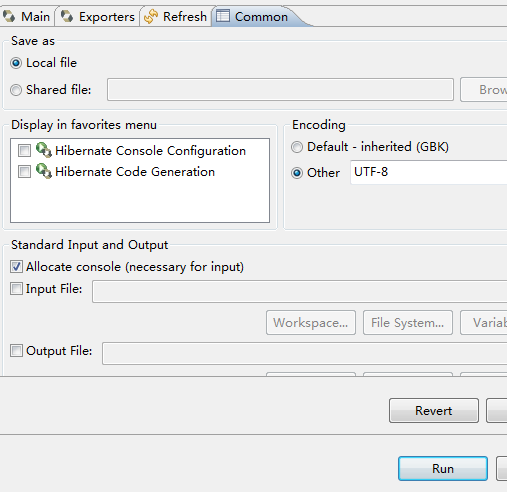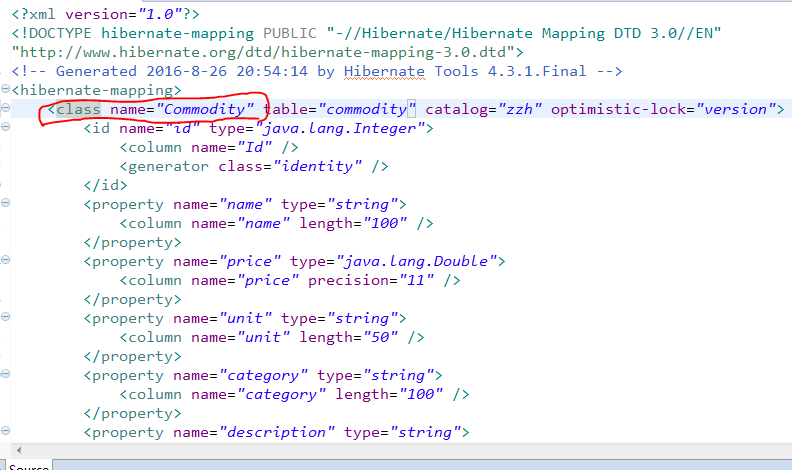JPA规范推荐使用Annotation来管理实体类与数据表之间的映射关系,从而避免同时维护两份文件(Java 实体类 和 XML 映射文件),将映射信息(写在Annotation中)与实体类集中在一起。
以下我将使用eclipse来构建一个简单使用注解取代*.hbm.xml的查询小例子。(p.s 建议不要使用Myeclipse,他很方便但是对于初学者来说没有eclipse学得牢靠)
1.在数据库中构建一张表

2.生成相应的hibernate.cfg.xml文件

<?xml version="1.0" encoding="UTF-8"?> <!DOCTYPE hibernate-configuration PUBLIC "-//Hibernate/Hibernate Configuration DTD 3.0//EN" "http://www.hibernate.org/dtd/hibernate-configuration-3.0.dtd"> <hibernate-configuration> <session-factory> <property name="hibernate.dialect">org.hibernate.dialect.MySQLDialect</property> <property name="hibernate.connection.driver_class">com.mysql.jdbc.Driver</property> <property name="hibernate.connection.password">root</property> <property name="hibernate.connection.url">jdbc:mysql://localhost:3306/zzh</property> <property name="hibernate.connection.username">root</property> <property name="show_sql">true</property> <property name="hbm2ddl.auto">update</property> </session-factory> </hibernate-configuration>
注意,在生成cfg.xml文件时,要create Hibernate Console Configuration


3.生成hibernate.reveng.xml逆向工程

<?xml version="1.0" encoding="UTF-8"?> <!DOCTYPE hibernate-reverse-engineering PUBLIC "-//Hibernate/Hibernate Reverse Engineering DTD 3.0//EN" "http://hibernate.sourceforge.net/hibernate-reverse-engineering-3.0.dtd" > <hibernate-reverse-engineering> <table-filter match-catalog="zzh" match-name="commodity"/> </hibernate-reverse-engineering>
在Eclipse界面工具栏,择Hibernate code generation Configuration,new 一个新的配置。

4.选择Exporters的选项,接下来是重点!!!

选择勾选的两项,不再选.hbm.xml.

点击Run。
5.只生成了与数据表对应的实体类Commodity.java,而没有生成与该实体类对应的映射文件Commodity.hbm.xml,打开实体类
package com.zzh; // Generated 2016-8-28 9:42:01 by Hibernate Tools 4.3.1.Final import javax.persistence.Column; import javax.persistence.Entity; import javax.persistence.GeneratedValue; import static javax.persistence.GenerationType.IDENTITY; import javax.persistence.Id; import javax.persistence.Table; /** * Commodity generated by hbm2java */ @Entity @Table(name = "commodity", catalog = "zzh") public class Commodity implements java.io.Serializable { private Integer id; private String name; private Double price; private String unit; private String category; private String description; private Integer seller; public Commodity() { } public Commodity(String name, Double price, String unit, String category, String description, Integer seller) { this.name = name; this.price = price; this.unit = unit; this.category = category; this.description = description; this.seller = seller; } @Id @GeneratedValue(strategy = IDENTITY) @Column(name = "Id", unique = true, nullable = false) public Integer getId() { return this.id; } public void setId(Integer id) { this.id = id; } @Column(name = "name", length = 100) public String getName() { return this.name; } public void setName(String name) { this.name = name; } @Column(name = "price", precision = 11) public Double getPrice() { return this.price; } public void setPrice(Double price) { this.price = price; } @Column(name = "unit", length = 50) public String getUnit() { return this.unit; } public void setUnit(String unit) { this.unit = unit; } @Column(name = "category", length = 100) public String getCategory() { return this.category; } public void setCategory(String category) { this.category = category; } @Column(name = "description", length = 1000) public String getDescription() { return this.description; } public void setDescription(String description) { this.description = description; } @Column(name = "seller") public Integer getSeller() { return this.seller; } public void setSeller(Integer seller) { this.seller = seller; } }
使用@Entity注解,表示当前类为实体Bean,需要进行持久化,使用@Table注解实现数据表 commodity 与持久化类Commodity之间的映射,@Id注解指定当前持久化类的ID属性,使用@GeneratedValue注解指定ID表示生成器,使用@Column注解指定当前属性所对应的数据表中的字段,name指定字段名;unique指定是否为唯一,nullable指定是否可为null。
6.在hibernate.cfg.xml中配置映射信息
<mapping class="com.zzh.Commodity"/>
一定要注意mapping后面是class,如果是配置*.hbm.xml就是resource。
7.添加会话工厂类HibernateUtil以获取Session

package com.zzh.utl; import org.hibernate.Session; import org.hibernate.SessionFactory; import org.hibernate.boot.registry.StandardServiceRegistry; import org.hibernate.boot.registry.StandardServiceRegistryBuilder; import org.hibernate.cfg.Configuration; public class HibernateUtil { private static SessionFactory sessionFactory; private static Session session; static { // 创建Configuration对象,读取hibernate.cfg.xml文件,完成初始化 Configuration config = new Configuration().configure(); StandardServiceRegistryBuilder ssrb = new StandardServiceRegistryBuilder() .applySettings(config.getProperties()); StandardServiceRegistry ssr=ssrb.build(); sessionFactory=config.buildSessionFactory(ssr); } //获取SessionFactory public static SessionFactory getSessionFactory(){ return sessionFactory; } //获取Session public static Session getSession(){ session=sessionFactory.openSession(); return session; } //关闭Session public static void closeSession(Session session){ if(session!=null){ session.close(); } } }
8.用JUnit创建一个类ZhuShi.java用于测试
package anno; import static org.junit.Assert.*; import java.util.List; import org.hibernate.Query; import org.hibernate.Session; import org.junit.After; import org.junit.Before; import org.junit.Test; import org.hibernate.annotations.*; import com.zzh.Commodity; import com.zzh.utl.HibernateUtil; public class ZhuShi { Session session = null; @Before public void setUp() throws Exception { session = HibernateUtil.getSession(); } @After public void tearDown() throws Exception { session.close(); } @Test public void test() { String hql = " from Commodity "; Query query = session.createQuery(hql); List<Commodity> c = query.list(); for (Commodity commodity : c) { System.out.println("name"+commodity.getName()); } } }
9.整个文件已经形成

运行测试,得到结果

10.总结
原来大量的*.hbm.xml文件不再需要了,所有的配置都通过Annotation注解直接在持久化类中配置完成。
11.个人想法
之前我有过不用注解后来因为路径调试半天的经历,那时自己也是笨,我就跟大家讲讲;我当时也是用反向工程生成实体类,还有*.hbm.xml文件,当时的hbm.xml文件如下所示:(注意看我红笔画出的部分)

由于是工具帮我生成的我也没在意,然后高高兴兴去配置cfg.xml文件去了(如下所示):

全部文件如下所示:

以为一切顺利,便用JUnit进行测试:

实体类无法找到,坑爹呀,我都是按工具一步一步来的呀,为什么会这样,后来才发现*.hbm.xml中class便签中name出错了,必须加上包名才行:

再进行测试:

总算成功了,这不代表*.hbm.xml不好,其实主要还是怪自己经验不足,乱用工具,初学者还是多用*.hbm.xml文件要好,毕竟能更好掌握其中的元素和映射信息与方式,不过就以后熟练后,还是用注释更为简洁和方便管理。
如果你觉得还不错,请继续关注我或帮我点赞,谢谢观看!
---参考资料《Struts2+Spring3+Hibernate框架技术精讲与整合案例》
